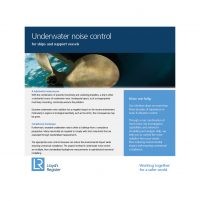
Lloyd Register offers new underwater noise notations
The underwater noise specialists within Lloyd’s Register (LR) are helping vessel owners to quantify operational noise levels and better understand the resultant environmental impact. With more than 30 years of experience, this team provides a thorough understanding of the complex acoustics involved to ensure reliable measurements and to provide ship owners with competent advice to reduce underwater noise (UWN). LR’s experts can identify suspect machinery, unfavorable vessel layout or inappropriate mounting that commonly worsen the acoustic emissions from machinery, and/or self-induced noise (e.g. hull hydrodynamic effects). Advanced numerical modeling and prediction analysis tools can identify unnecessary vibration in new-build plans, as well as ensure contractual compliance in minimizing a new ship’s noise. Accurate measurements and predictions can be done for certification under Lloyd Register’s underwater noise notations UWN-M and UWN-L.
The LR UWN notation and ShipRight procedure on underwater radiated noise helps ship owners define their ships’ UWN emissions. The UWN notation describes three criteria curves: transit, quiet, research, and includes a speed indication. The curves apply to vessels underway (straight ahead and at constant speed). They are intended to be an indication of operational mode for various types of vessels. In general, Transit applies to normal operating conditions while underway, Quiet is intended for areas which may be environmentally sensitive and Research for vessels conducting marine research. For example, UWN-L (T20) would mean that the vessel meets the underwater noise criteria in transit (T) at a speed of twenty knots.
To find out more, visit LR website or contact their team by email.